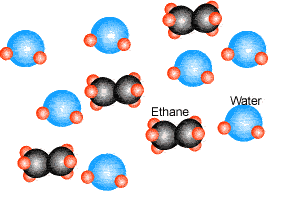Hydrocarbons
Solubility of ethane
Ethane is a symmetrical molecule. Weak forces of attraction, known as dispersion forces, exist between the molecules of ethane. The forces of attraction between ethane and water are not strong enough to overcome the hydrogen bonding that exists between the water molecules.
Watch the animation on the right. Notice how the ethane molecules will group together. This minimises the surface area exposed to water. This formation has a lower energy state.

Explain why ethane is likely to dissolve in carbon tetrachloride (CCl4).
Explain why ethanol(CH3CH2OH), at room temperature, is a soluble liquid while ethane is an insoluble gas.
Why is ammonia(NH3) highly soluble in water?
Would you expect salt to dissolve in ammonia as it does in water?
Solution